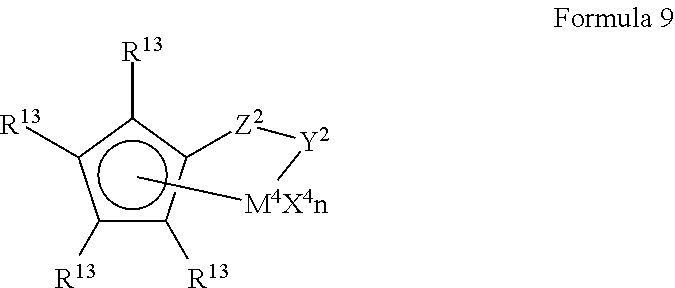Polyethylene Powder for Fiber, Fiber, and Article
a technology of polyethylene powder and fiber, applied in the field of polyethylene powder for fiber, fiber, and article, can solve the problems of reduced mechanical properties, easy degradation, embrittlement, discoloration, etc., and achieve the effect of excellent color tone and high drawing
- Summary
- Abstract
- Description
- Claims
- Application Information
AI Technical Summary
Benefits of technology
Problems solved by technology
Method used
Image
Examples
reference example 1
Catalyst Synthesis Example 1
Preparation of Solid Catalytic Component [A]
[0179]To an 8 L stainless autoclave purged with nitrogen, 1,600 mL of hexane was added. To this autoclave, 800 mL of a hexane solution containing 1 mol / L titanium tetrachloride and 800 mL of a hexane solution containing 1 mol / L organic magnesium compound represented by the compositional formula AlMg5(C4H9)11(OSiH)2 were added at the same time over 4 hours with stirring at 10° C. After the addition, the mixture was gradually heated, and the reaction was continued at 10° C. for 1 hour. After the completion of the reaction, 1,600 mL of the supernatant was removed, and the resulting solid was washed with 1,600 mL of hexane ten times to prepare solid catalytic component [A]. The amount of titanium contained per g of this solid catalytic component was 3.05 mmol.
reference example 2
Catalyst Synthesis Example 2
Preparation of Solid Catalytic Component [B]
(1) Synthesis of Carrier (B-1)
[0180]An 8 L stainless autoclave fully purged with nitrogen was charged with 1000 mL of a hexane solution containing 2 mol / L hydroxytrichlorosilane, and 2550 mL (corresponding to 2.68 mol of magnesium) of a hexane solution of an organic magnesium compound represented by the compositional formula AlMg5(C4H9)11(OC4H9)2 was added dropwise thereto over 4 hours with stirring at 65° C. The reaction was continued with further stirring at 65° C. for 1 hour. After the completion of the reaction, the supernatant was removed, and the resulting solid was washed with 1800 mL of hexane four times. As a result of analyzing this solid (carrier (B-1)), 8.31 mmol of magnesium was contained per g of the solid.
(2) Preparation of Solid Catalytic Component [B]
[0181]To 1970 mL of the hexane slurry containing 110 g of the carrier (B-1), 110 mL of a hexane solution containing 1 mol / L titanium tetrachloride ...
reference example 3
Catalyst Synthesis Example 3
Preparation of Supported Metallocene Catalytic Component [C]
[0182]Spherical silica having an average particle size of 15 μm, a surface area of 700 m2 / g, and an intra-particle pore volume of 1.8 mL / g was fired at 500° C. for 5 hours in the nitrogen atmosphere for dehydration. The amount of surface hydroxy groups on the dehydrated silica was 1.85 mmol / g per SiO2. In a 1.8 L autoclave, 40 g of this dehydrated silica was dispersed in 800 mL of hexane in the nitrogen atmosphere to obtain slurry. While the temperature of the obtained slurry was kept at 50° C. with stirring, 80 mL of a hexane solution of triethyl aluminum (concentration: 1 mol / L) was added thereto. Then, the mixture was stirred for 2 hours such that the triethyl aluminum was reacted with the surface hydroxy groups of the silica to obtain component [a] containing triethyl aluminum-treated silica (in which the surface hydroxy groups of the triethyl aluminum-treated silica were capped by the trieth...
PUM
| Property | Measurement | Unit |
|---|---|---|
| particle size | aaaaa | aaaaa |
| particle size | aaaaa | aaaaa |
| particle size | aaaaa | aaaaa |
Abstract
Description
Claims
Application Information
 Login to View More
Login to View More - R&D
- Intellectual Property
- Life Sciences
- Materials
- Tech Scout
- Unparalleled Data Quality
- Higher Quality Content
- 60% Fewer Hallucinations
Browse by: Latest US Patents, China's latest patents, Technical Efficacy Thesaurus, Application Domain, Technology Topic, Popular Technical Reports.
© 2025 PatSnap. All rights reserved.Legal|Privacy policy|Modern Slavery Act Transparency Statement|Sitemap|About US| Contact US: help@patsnap.com

